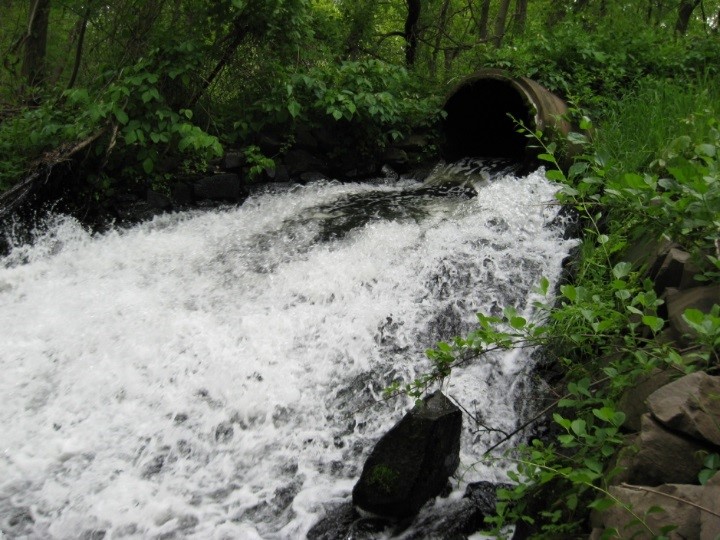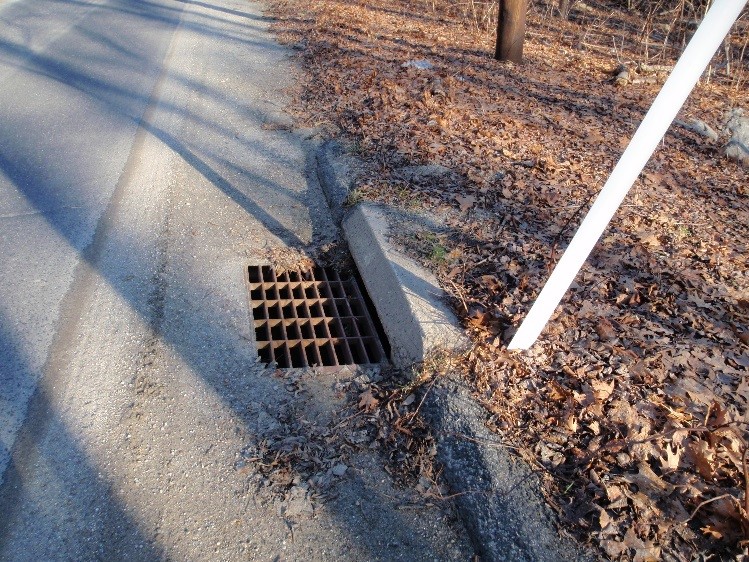Stormwater and Water Quality
What is Stormwater?
 Stormwater is rain or snowmelt that runs off the landscape. In the natural environment, this water is absorbed by plants and soil as part of the water cycle. However, hard surfaces in developed areas such as rooftops, paved streets, highways and parking lots, block this natural absorption from occurring. Stormwater will pick up and transport contaminants including motor oils, gasoline, antifreeze, and brake dust (commonly found on pavements), fertilizers and pesticides (found on landscaped areas), and soil sediments (from farms, construction and other sites). The stormwater eventually flows into a local stream, river, lake, or estuary.
Stormwater is rain or snowmelt that runs off the landscape. In the natural environment, this water is absorbed by plants and soil as part of the water cycle. However, hard surfaces in developed areas such as rooftops, paved streets, highways and parking lots, block this natural absorption from occurring. Stormwater will pick up and transport contaminants including motor oils, gasoline, antifreeze, and brake dust (commonly found on pavements), fertilizers and pesticides (found on landscaped areas), and soil sediments (from farms, construction and other sites). The stormwater eventually flows into a local stream, river, lake, or estuary.
Effects of Stormwater on Water Quality
Water quality conditions of a waterbody determine how it can be used by people and living things. Water quality is measured by testing the physical, chemical and biological conditions and by looking at how a waterbody can be used for water supply, swimming, fishing, shellfishing and aquatic life. If the water quality is good then the environmental conditions support these uses. If the water quality is poor then the uses are impacted by the environmental conditions in the waterbody. Stormwater runoff can have a negative effect on water quality as the contaminated stormwater mixes with surface water.
Stormwater can contribute the following:
- Increased Temperature
- Increased Flow Volume
- Suspended Solids
- Bacteria and Pathogens
- Decreased Dissolved Oxygen
- Nutrients (nitrogen and phosphorus)
- Toxic Compounds (metals, pesticides, petroleum products, PCBS, etc.)
- Sediment
- Litter and Trash
Rainfall in Urban Areas
 As the human population increases, the urban environment is steadily growing, expanding the areas that are composed of hard surfaces. these areas accelerate the transport of stormwater and contaminants through storm drains where it is released into a local waterbody. As urban areas develop, it is important that stormwater is properly managed to protect water quality throughout our State.
As the human population increases, the urban environment is steadily growing, expanding the areas that are composed of hard surfaces. these areas accelerate the transport of stormwater and contaminants through storm drains where it is released into a local waterbody. As urban areas develop, it is important that stormwater is properly managed to protect water quality throughout our State.
Stormwater Pollution Management
The Department of Energy and Environmental Protection relies on multiple tools and measures to improve water quality. These tools may be used independently or in combination to reduce the impact of stormwater pollution. Below are a few tools that are commonly applied to manage discharges to water bodies while preserving water quality.
General Permits for Stormwater
There are several types of general permits the Department issues under the federal Clean Water Act National Pollutant Discharge Elimination System (NPDES) which requires steps to control stormwater pollution from entering its storm sewer systems and waterbodies. These include:
- The General Permit for the Discharge of Stormwater from Small Municipal Separate Storm Sewer Systems (MS4 General Permit) requires Connecticut municipalities with densely populated areas to implement measures as part of the USEPA Phase II Stormwater Program (1999).
- The General Permit for the Discharge of Stormwater and Dewatering Wastewaters from Construction Activities requires controls to reduce the discharge of sediment during construction and includes measures to address the long term impacts related to post-construction stormwater discharges.
- The General Permit for the Discharge of Stormwater Associated with Industrial Activity requires the development and implementation of a Stormwater Pollution Prevention Plan (SWPPP) that must include control measures to reduce or eliminate the discharge of pollutants from the site.
- The General Permit for the Discharge of Stormwater Associated with Commercial Activity regulates large commercial sites with impervious surfaces exceeding 5 acres and requires a plan to control stormwater pollutants from these sites.
Total Maximum Daily Load (TMDL)
A TMDL is a pollution reduction plan which can be thought of as a pollution budget. A waterbody that is overspending its daily budget for a substance is considered to be polluted or impaired. TMDLs provide the framework for restoring impaired waters by establishing the maximum amount of a pollutant that a waterbody can receive without adverse impact to fish, wildlife, recreation, or other uses. For more information, go to www.ct.gov/deep/tmdl.
Watershed Response Plan for Impervious Cover (IC)
A Watershed Response Plan is a tool used to improve water quality in local waters. This type of plan offers water quality information and guidance for all members of the local community, including the public, municipal officials, businesses and watershed groups. The Watershed Response Plan for Impervious Cover (IC Response Plan) provides details on the local watershed conditions, impervious cover (IC), and implementation measures. The local community can use the IC Response Plan to complement existing stormwater practices and Infrastructure management. Improving stormwater quality and reducing runoff can reduce its negative effects and restore water quality in the local waterbodies. For more information and to see the components of the IC Response Plan, go to the Stormwater Planning Tool for Impervious Cover.
For more information:
View the interactive maps to learn more about stormwater pollution management plans in Connecticut.
To read more about stormwater in a specific town, choose from the list below.
- Compose an email to listserv@list.ct.gov from the email address you wish to have added.
- You may leave the subject line blank, and in the body of the message type:
Subscribe DEEP_WQPlanning YourFirstName YourLastName
(Substitute your first and last name here.)
Note:If you have an e-mail signature, header, and/or footer set up to be automatically included in emails, you will need to delete these before sending the subscribe request. - After you send the email, you will receive an e-mail confirmation request. Follow the directions to confirm your email address.
- You will then receive an e-mail that you have successfully subscribed to the listserv.
-
Compose an e-mail to listserv@list.ct.gov
-
Leave the subject line blank and in the body of the message type:
Signoff DEEP_WQPlanning -
Requests to unsubscribe must be sent from the same email account used when subscribing to the email list.
-
You will then receive an e-mail that you have successfully unsubscribed from the listserv.

